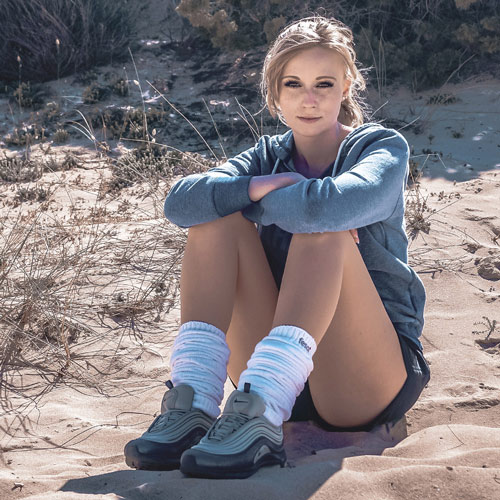What are slouch socks?
Slouch socks or loose socks (ルーズソックス, rūzu sokkusu) are socks with a particularly long and wide upper. Due to their design, the socks do not lie directly on the leg, but can be gathered downwards in a pleated look. When worn, the socks are reminiscent of leg warmer cuffs, with the difference that the cuff and the foot section are not separated in the slouch sock. Slouch socks are typically white. The socks often have a total length of 100 to 150 centimeters, sometimes they are even up to 200 centimeters long.
In the 1990s in particular, slouch socks were worn by many Japanese middle and upper class schoolgirls together with their school uniform. While they were generally combined with very classic leather shoes in Japan back then, today they are usually paired with sneakers.
The history of slouch socks
There are several versions regarding the history of the origin of the eye-catching slouch socks. What they all have in common, however, is that they originated in Japan. The most plausible story is the one we would like to present to you below.
In Japanese schools, it was and still is largely compulsory to wear a school uniform. The school rules stipulated skirts for girls and pants for boys. Until the 2000s, teachers were very strict in ensuring that their pupils wore the correct uniform. For female students from the northern cities of Japan, this posed a particular challenge in winter. As they were obliged to wear a skirt on the one hand, but tights were forbidden by school regulations on the other, the girls regularly had to freeze in frosty temperatures.

Schoolgirls from the Japanese city of Sendai did not want to put up with constantly freezing in frosty temperatures, while their male classmates came to school much more weatherproof in pants. As the school rules prohibited tights but were not very specific about socks, the girls started wearing thick, long socks. In the cold, they could pull them way up and pull them down to their shoes in the warm classrooms. The girls' small rebellion against the school rules and the associated look quickly spread to major cities such as Osaka and Tokyo. It wasn't long before schoolgirls all over Japan started wearing thick socks with their school uniforms. Eventually, the industry became aware of the youth culture. Sock manufacturers began to produce longer and longer socks. Skin-friendly adhesives were even developed to ensure a perfect fit. They were designed to keep the socks perfectly on the leg and prevent the layers from slipping.
Slouch socks reached the peak of their popularity in Japan between 1996 and 1998, with some schools even going so far as to ban the eye-catching socks in their school rules. While their popularity in Japan waned after 1998, the socks remained in people's minds worldwide as a symbol of the Kogyaru or Kogal youth movement.
Brands such as fesoi are now re-establishing the trend - in their own interpretations. fesoi slouch socks combine Japanese youth culture with today's street style. Perfect with sneakers, these slouch socks are both an it-piece and a statement.

